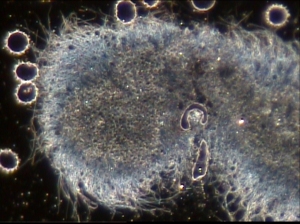If you’ve been in one of my classes on EcoBiotics and DIAD Microscopy, you know that my theory of Enderlein-style progressive pleomorphism, which on its face seems biologically impossible, can be explained by a mechanism in which the timeline of previous microbial devolution within the lineage of a host’s interior ecosystem actually runs in reverse. This gives the impression that microorganisms rapidly undergo something like spontaneous generation, presenting complexity that seemingly comes from out of nowhere. This is part of what Enderlein and others have described and what we see with a DIAD challenge under the microscope. But it’s rejected by mainstream biology and medicine because it seems totally impossible.
In my original paper on the subject, I suggested that this whole process – which I called ambimorphic provolution – is triggered by a prion-like shift from a passive, endogenous alpha-helix protein (the alpha-provon) to an unfolded, beta-sheet conformation (the beta-provon) that acts as a triggering and scaffolding mechanism to direct the reassembly of hidden, cached materials within the terrain to recapitulate prior, cellular states.
I’ve also suggested that some of the massive, filamentous and fractal forms observed in reaction to a DIAD challenge are made of provons attaching to one another, rather than engaging in provolutionary cell synthesis processes, or, at a somewhat lower level of complexity, morphological markers for living cells.
This way of thinking, which I’ve been working on for about 15 years now, is way, way out on a limb. Lynn Margulis’ work on endosymbiosis (the most famous example of which is the bacterial origin of mitochondria), was a real shot in the arm for the basic concept of endo-ecological pleomorphism, but extrapolating the mechanism to biological exotica like prions and endogenous retroviruses is something of a stretch. It has always felt right to me and has beautifully matched thousands of empirical observations but it is still, in essence, a speculative theory.
Well, in that serendipitous way that’s been guiding me for the better part of 2 decades, I have come across 2 new (for me, at least) pieces of information that dovetail with my wildest speculations. First, I didn’t know (and how could I have missed it?) that there exists a quixotic class of fungal prions. And rather than creating disease, these prions are thought by some researchers to actually contribute to the ability of some fungi to rapidly change their behavior in response to environmental cues! In fact, to adapt far more rapidly than genetic, rather than epigenetic, mechanisms would allow. This is EXACTLY what I have been suggesting for the prion-directed dynamics of provons (provolutionary prions).
Furthermore, when the beta-form of these fungal prions link, they create fibrils that can, depending upon how they associate, take on different forms, from filaments to masses…just like my speculation about the provon origin of many types of symplasts observed in the blood, especially in reaction to a DIAD developer. Remember, in my conception the DIAD developers contain alpha-provons which are “sitting ducks,” easily and exponentially corrupted by any matching beta-provons already in the blood. By the way, these prion-like particles are cell-membrane proteins, which might explain part of why DIAD reactions so often alter cell membranes.
Finally (for now at least), the action of these fungal prions is dependent upon their concentration, sometimes leading to paradoxical effects – just like the difference between adding a Sanum remedy to the body (low concentration, leading to the slow, subtle, developmental process of regulator synthesis) vs. adding it to the blood sample on a slide (high concentration, leading to provon-provon interactions which can result in recycler synthesis, or direct massing of converted provons into fibrils or other massive structures).
This is exciting. As usual, where I have taken these ideas is totally different from the context in which other biologists have made their discoveries and done their research. But the shape of the ideas is so similar I find it a real boost to the concept of provolution and the notion that nature can evolve adaptive responses that incorporate these exotic mechanisms.
Two good places to start following up about this are a short article on Wikipedia about fungal prions (http://en.wikipedia.org/wiki/Fungal_prions) and an article about the discovery of a way to break down normally protease resistant prions (http://www.wi.mit.edu/news/archives/2004/sl_0520.html ).
If you’re interested, take a look – this is an exciting new avenue to explore – and contact me if you’re interested in pushing the envelope.
